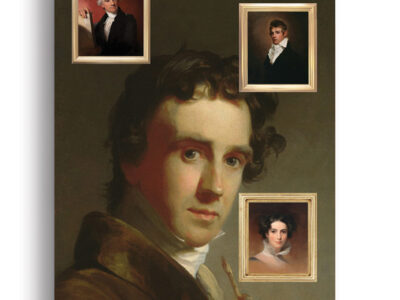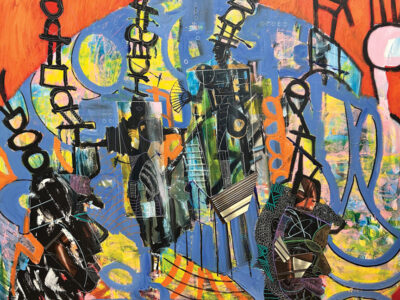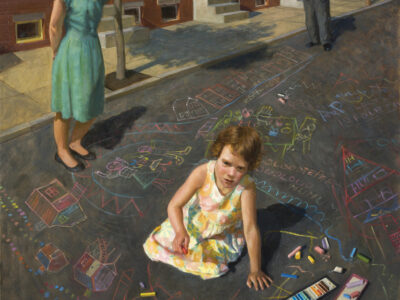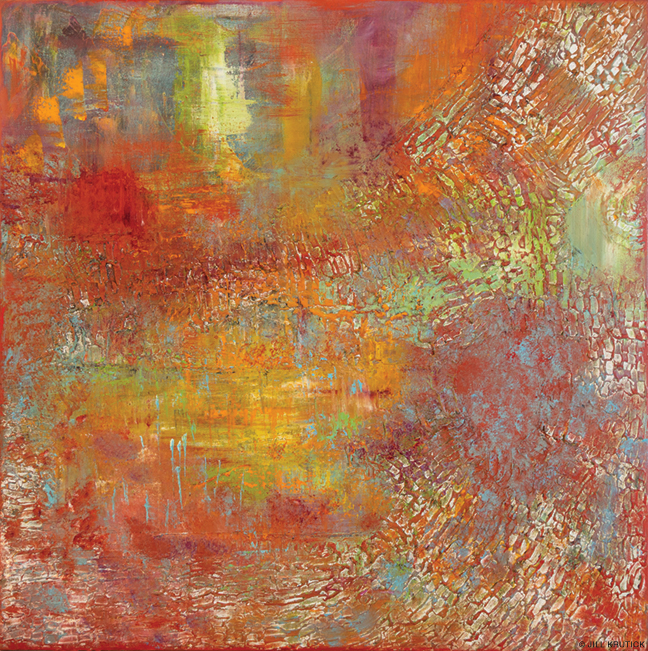
Jill Krutick finds her happy place.
Jill Krutick W’84 was supposed to wrap up this autumn in Brussels. Following a later-in-life foray into the professional art world, she’d been on a roll through 2019 and into early 2020, landing her first solo museum show plus a dozen other exhibition opportunities. Another crop of shows was on the way, including more US museum exhibitions and a November art fair in Brussels.Then the pandemic swept in and cleared her entire calendar.
Instead of packing up her abstract expressionist paintings to introduce in Europe, Krutick has been penned inside her Mamaroneck, New York, studio since March, making new work while trying to figure out how an artist can stay visible when museums and galleries are shut.
That’s where her Wharton days and previous career are proving handy. Harnessing what she learned during 23 years in the business world, Krutick is using all this unplanned downtime to reach art enthusiasts and collectors who, like her, are mostly stuck at home right now.
“I have tried basically every way to engage with people and keep people interested and wanting to view my work, buy my work,” she said during a virtual presentation at Homecoming in November. Since March, that’s included TikTok and Instagram videos of her painting process, a new Etsy shop, a home art curation service, a virtual viewing room, a perpetually updated website, and “storytime” videos about each of her painting series.
In her most-viewed TikTok video, posted in June, Krutick’s gloved hand drags a palette knife across a white canvas, smoothing on white molding paste. It’s like watching a pastry chef frost a very large, very flat cake. A soft cover of Maroon 5’s “Sunday Morning” accompanies the clip, along with the caption, “Molding paste is calming,” followed by a series of tags: #satisfyingpainting #foryoupage #processvideo #moldingpaste.
Aside from supplying Zen footage, this process is how Krutick begins many of her paintings. She’ll cover an entire canvas with textured acrylic molding paste, then sculpt in lines, swirls, and abstract shapes. “As I’m creating it, I might see a story coming out,” she says. In a video on her website, Krutick steps back to study a large canvas that she’s already coated and carved. “I see a lot of vegetation,” she says. “I see a lot of fairytale elements. It’s certainly a happy place.”
She layers colorful paint over the textured paste, swiping on ocean blues and soft reds and pale greens in the video. Color is Krutick’s other passion. She “collects” it everywhere she goes, relying on her strong visual memory to capture a stroll under fiery autumn leaves or a boat ride on a foggy day.
In her abstract works, Krutick’s inspiration has swung from Batmanto The Giving Tree to trout. (Her son is a fishing captain in Miami and suggested that last one.) “Inspiration comes from a lot of different places,” she says. “Sometimes they’re just fantasy worlds that I dream about,” as in her Shangri la series, which has hints of Monet. “There are so many different ways that I get transported as I’m painting,” she adds, “which is why I call it taking a journey.”
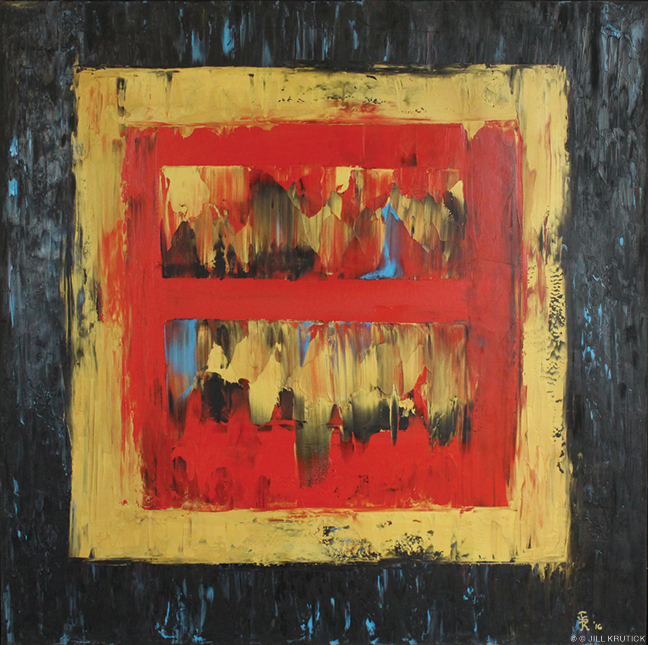
Krutick’s Ice Cube series draws inspiration from Mark Rothko’s color-field paintings, but often incorporates harder edges and brasher contrasts. She explains on her website that “the Ice Cube shape”—two drippy rectangles separated by a thick band and placed inside a square—“has emerged as my artistic fingerprint.”
“It’s a very unique series, which stands apart from all my other series,” she says. She’s made more than a hundred of them at this point, in various sizes and colors.“The actual image, while simple, is actually very complex when you take a closer look—in terms of the textures and the layers and the nuances that are on the canvas,” she says. “You can actually see so much in what appears to be a simple picture.”
Like many artists, Krutick remembers falling in love with her craft as a kid. By her teen years, she was copying famous Monet and Van Gogh works in oil. But in college she studiedfinanceand decision sciences at Wharton, followed by a 17-year career on Wall Street and then six years as a senior vice president at Warner Music Group. When Warner was taken private in 2011, she threw herself back into painting. Soon “all of that energy that I put into finance got directed into building an art practice,” she says.
She spent four years taking classes at the Art Students League of New York, learningfrom her teachers as well as the other students.
The more she painted, the more she wanted to paint. By 2017, she had her own studio/gallery. In early 2019, at age 56, she landed her first museum show. “That was a milestone event for me,” she says, recalling the 5,000 square feet—six rooms in all—inside the Coral Springs Museum of Art in Florida that were filled with her work.
Another museum show sprang from that one, then another and another, until Krutick had major momentum and a busy travel schedule heading into 2020. You know what happened next.
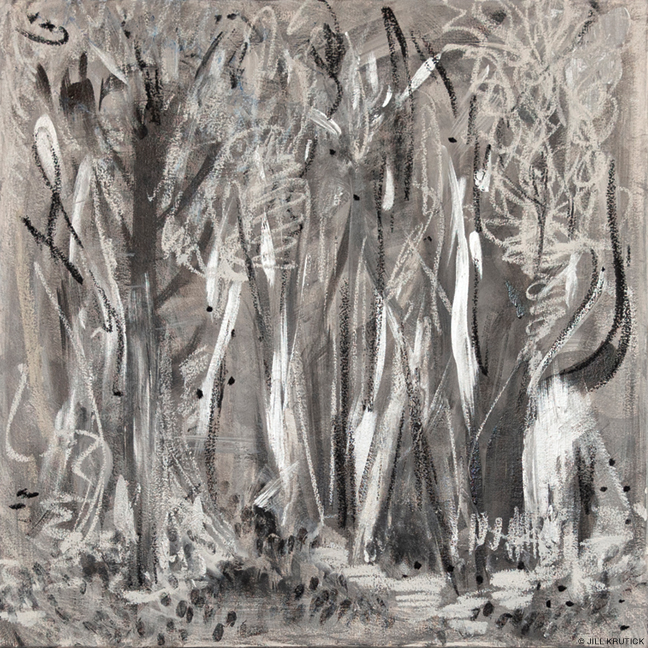
But she’s managed to find slivers of light in a dark year. “All I did was try to dream up new ways to reach people,” she says. “That was the silver lining: instead of just pressing ahead with the shows and preparing for those specific events, I took a blank sheet and started from scratch, thinking about how to create a virtual experience and share the art in new and different ways.”
The Etsy store, for one. Launched this past October, it places Krutick’s paintings on yoga pants, duvet covers, note cards, and cloth face masks, in addition to serving as an online shop for her original paintings. “It’s a very tough market overall because people are in a very bad way,” she says. “I believe it’s important to continue to be in front of people and to show that you’re constantly reinventing yourself.”
With the Brussels show rescheduled for February 2021, Krutick is also preparing to mount a solo exhibition at Virginia’s Longwood Center for the Visual Arts and an “Homage to Rothko” solo show at the Alex Galleries in Washington, DC, both postponed from 2020, sometime this coming year.
“The fun of the story is that I didn’t have a specific plan to get to art later in life,” she says. “It’s something that just happened—an unplanned decision.”
“But there were always two parts of me,” she adds, “the artsy part and the business part. I knew that they had to live together. Now in the art world, seeing how important business is as part of this whole equation—how you market yourself and differentiate yourself in the wacky world of art—it’s fascinating to me how it all comes together.”
—Molly Petrilla C’06


